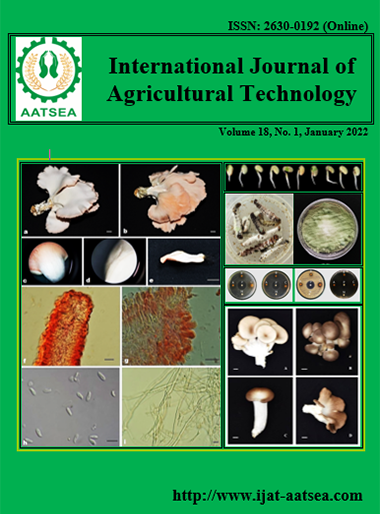Identification of lovastatin analogs-producing Pleurotus cultivars in southern Vietnam
Main Article Content
Abstract
Pleurotus mushrooms have been widely cultivated worldwide due to their nutritional and medicinal value. Numerous bioactive compounds such as polysaccharides, polyphenols, proteins, and amino acids, have been well documented in its fruiting bodies. However, lovastatin known as an anti-lipidemic medicinal compound produced by several Pleurotus strains is neglected. This study aimed to identify local Pleurotus strains capable of producing lovastatin analogs collected from southern Vietnam. Accordingly, 31 Pleurotus strains were isolated and belonged to 5 morphotypes: blue oyster, golden oyster, abalone, oyster, and phoenix. Lovastatin analogs were detected using a state-of-the-art method quantitative 1H nuclear magnetic resonance (qHNMR). As a result, among 31 strains of Pleurotus mushrooms, 4 strains were capable of synthesizing lovastatin analogs. In which, one strain belonged to oyster morphotypes (Pleurotus ostreatus s. l.) and 3 strains were phoenix morphotypes (Pleurotus pulmonarius s. l.). This is the first to identify the production of lovastatin analogs by phoenix mushrooms.
Article Details

This work is licensed under a Creative Commons Attribution-NonCommercial-NoDerivatives 4.0 International License.
References
Abdul, R. N. and Aneeqa, G. (2021). Different ways to exploit mushrooms: A review. All Life, 14:450-460.
Alarcon, J., Aguila, S., Arancibia-Avila, P., Fuentes, O., Zamorano-Ponce, E. and Hernandez, M. (2003). Production and purification of statins from Pleurotus ostreatus (Basidiomycetes) strains. Verlag der Zeitschrift für Naturforschung, 58:62-64.
Buchanan, P. K. (1993). Identification, names and nomenclature of common edible mushrooms. In: Chang ST et al ed. Mushroom biology and mushroom products, Hong Kong, The Chinese University Press, pp.21-32.
Catalogue of Life (2021). Retrieved from https://www.catalogueoflife.org/?taxonKey=6SW5 in Aug 10th, 2021.
Chen, S., Ho, K., Hsieh, Y., Wang, L. and Mau, J. (2012). Contents of lovastatin, γ-aminobutyric acid and ergothioneine in mushroom fruiting bodies and mycelia. LWT - Food Science and Technology, 47:274-278.
Corner, E. J. H. (1981). Beihefte zur Nova Hedwigia, Heft 69: The Agaric Genera: Lentinus, Panus, and Pleurotus with particular reference to Malaysian species, Gantner Verlag Kommanditgesellschaft, J. Cramer, pp.102-111.
Dirk, W. L., Yulia, B. M., Thomas, K., Sigrid, L., Sibylle, M., Matthias, K., Asja, W. and Christian, S. (2012). NMR evaluation of total statin content and HMGCoA reductase inhibition in red yeast rice (Monascus spp.) food supplements. Chinese Medicine, 7:8.
Food and Agriculture Organization Corporate Statistical Database (FAOSTAT) (2021). Retrieved from http://www.fao.org/faostat/en/#data in Aug 10th, 2021.
Food Data Central, U.S. Department of Agriculture (2019). Retrieved from https://fdc.nal.usda.gov/fdc-app.html#/food-details/1750345/ nutrients in Aug 10th, 2021.
Iwona, G., Alina, K., Tomasz, S., Marek, S. and Krzysztof, S. (2018). Bioactive compounds and medicinal properties of Oyster mushrooms (Pleurotus sp.). Folia Horticulturae, 30:191-201.
Javier, B., Ailed P. and María, E. B. (2020). New knowledge about the biosynthesis of lovastatin and its production by fermentation of Aspergillus terreus. Applied Microbiology and Biotechnology, 104:8979-8998.
Julio, A. and Sergio, A. (2005). Lovastatin Production by Pleurotus ostreatus: Effects of the C:N Ratio. Journal of Biosciences, 61:95-8.
Lechner, B. E., Wright, J. E. and Alberto, E. (2004). The genus Pleurotus in Argentina. Mycologia, 96:845-858.
Lee, J. W., Lee, S. M., Gwak, K. S., Lee, J. Y. and Choi, I. G. (2006). Screening of edible mushrooms for the production of Lovastatin and its HMG-CoA reductase inhibitory activity. The Korean Journal of Microbiology, 42:83-88.
María, E. V., Talía, H. and Octavio, P. (2015). Edible mushrooms: improving human health and promoting quality life. International Journal of Microbiology, 2015:376-387.
Mbassi J. E. G., Mobou E. Y., Ngome F. A. and Sado K. S. L. (2018). Effect of substrates on nutritional composition and functional properties of Pleurotus ostreatus. Current Research in Agricultural Sciences, 5:15-22.
Mohammad, F. J., Juan, B. L., Yin, W. H., Rosfarizan, M., Yong, M. G. and Parisa, S. (2012). Lovastatin production by Aspergillus terreus using agro-biomass as substrate in solid state fermentation. BioMed Research International, 2012:11.
Pegler, N. D. (1986). Kew BulletinAdditional Series XII: Agaric flora of Sri Lanka, London, Her Majesty Stationary Office, pp.41-46.
Segedin, P. B., Buchanan, P. K. and Wilkie, J. P. (1995). Studies in the Agaricales of New Zealand: New species, new records and renamed species of Pleurotus (Pleurotaceaea). Australian systematic botany, 8:453-482.
Seress, P., Balogh, G., Olah, A. and Cseke, L. (2001). Metabolic controlled fermentation procedure for the manufacture of lovastatin hydroxy acid. U.S. Patent, 6:197-560.
Stéphane, O., Jean-Jacques, M., Antonio, G. and Eric, B. (2021). Coronaviruses, cholesterol and statins: Involvement and application for Covid-19. Biochimie, 189:51-64.
Tsiantas, K., Tsiaka, T., Koutrotsios, G., Siapi, E., Zervakis, G. I., Kalogeropoulos, N. and Zoumpoulakis, P. (2021). On the identification and quantification of ergothioneine and lovastatin in various mushroom species: assets and challenges of different analytical approaches. Molecules, 26:1832.
Vijay, V. P., Vinay, K. V. and Amit, P. (2019). Lovastatin: a journey from ascomycetes to basidiomycetes fungi. Journal of Biologically Active Products from Nature, 9:162-178.
World Health Organization (2021). Retrieved from https://www.who.int/health-topics/coronavirus#tab=tab_1 in Aug 10th, 2021.


